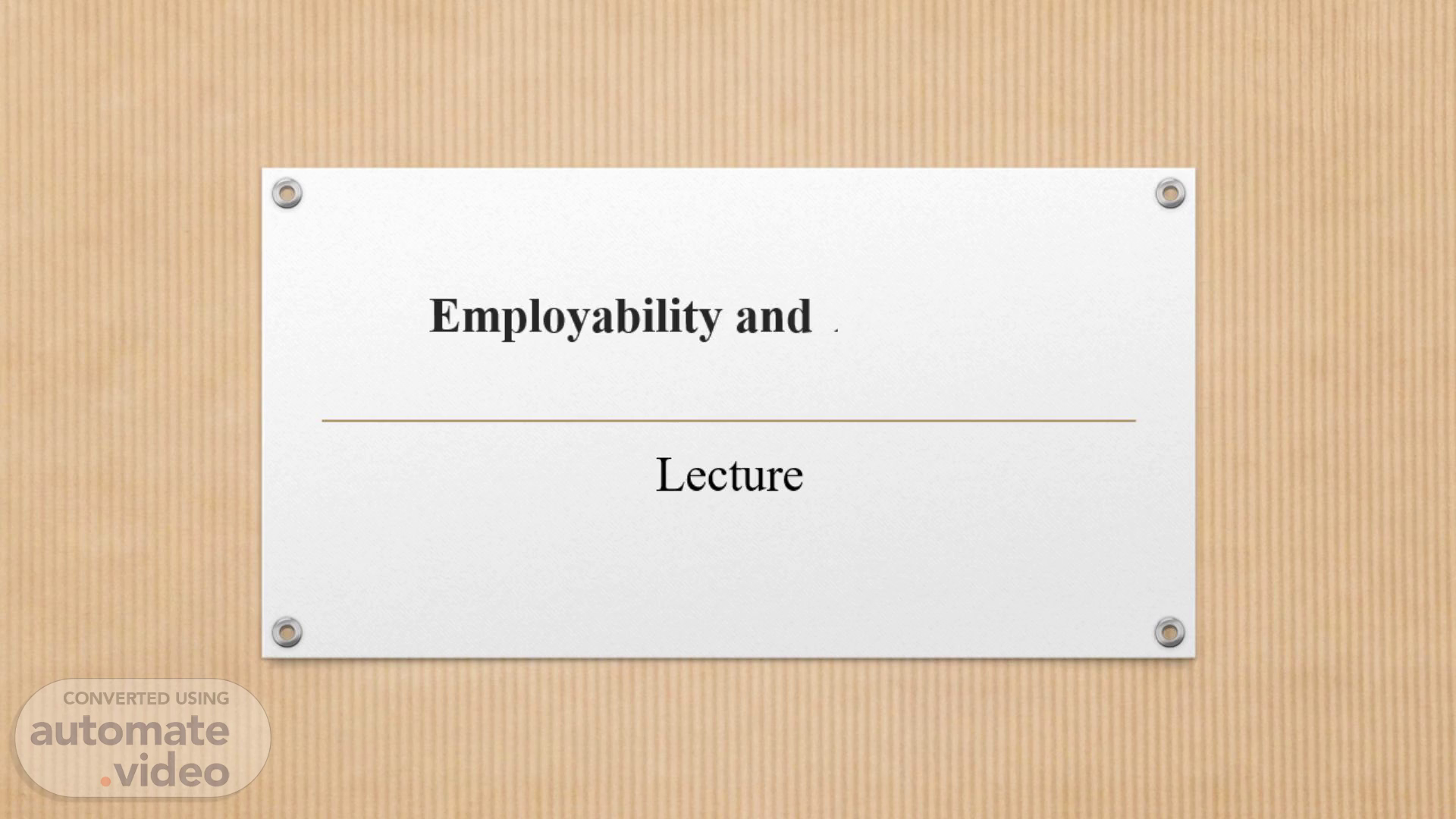Scene 1 (0s)
Employability and Attitudes. Lecture.
Scene 2 (6s)
Employability. Employability refers to the qualities and skills a person possesses that enable them to find and maintain employment. It goes beyond just technical skills and includes soft skills like problem-solving, communication, and adaptability. Improving employability is crucial for individual well-being, economic growth, and social cohesion, especially for groups facing labor market challenges..
Scene 3 (24s)
Key aspects of employability. Technical Skills: These are the specific skills required for a particular job, such as programming, accounting, or design. Soft Skills: Communication , Problem Solving , Team Work, Leadership, Adaptability. Other important factors: Work Ethic , Positive Attitude, Networking ,Lifelong Learning.
Scene 4 (40s)
ATTITUDE. In psychology, an attitude refers to a set of emotions, beliefs, and behaviors toward a particular object, person, thing, or event. Attitude can also be described as the way we evaluate something or someone. For example, we tend to respond positively or negatively about certain subjects..
Scene 5 (57s)
Types of Attitudes. Positive Attitude A positive attitude involves having a positive mindset and thinking about the greater good irrespective of what the situation is. It helps you to accept your strengths and weaknesses and stay resilient. A positive attitude is instrumental in academic and professional success. When someone has a positive attitude, they often display confidence, optimism, happiness, reliability and flexibility. For example, Ahmed’s manager gives him constructive feedback on his performance in a recent high-stakes project. If Anil has a positive mindset, he will thank his manager and work on the areas that need improvement..
Scene 6 (1m 23s)
Cont’d. Negative Attitude A negative attitude prevents people from looking at things with hope or happiness. It’s the opposite of having a positive mindset. Many times people face adverse circumstances that make them adopt a negative attitude towards life. Constantly feeling negative can affect one’s mental and physical well-being. Identify negative attitudes by labeling your emotions and monitoring your feelings. Anger, frustration and self-doubt are a few common symptoms. Reach out to a friend or consult a professional if you’re unable to resolve your negative feelings on your own..
Scene 7 (1m 47s)
Cultivating Positive Attitude. Resilience: Overcoming Challenges with Strength Resilience is the ability to bounce back from setbacks, failures, or hardships. A resilient person remains hopeful and determined, even in difficult situations. How it develops a positive attitude: Helps individuals see failures as learning experiences rather than defeats. Encourages perseverance and problem-solving instead of frustration and giving up. Reduces stress by fostering emotional strength and adaptability. Example: A student failing a test doesn’t view it as a reason to quit but as an opportunity to improve by studying harder..
Scene 8 (2m 12s)
Optimism: Seeing the Good in Every Situation. Optimism is the tendency to focus on the positives and expect favorable outcomes. An optimistic mindset enables people to face difficulties with hope and confidence. How it develops a positive attitude: Encourages individuals to believe that challenges are temporary and solutions exist. Reduces negative self-talk and fear of failure. Helps in maintaining motivation and enthusiasm for goals. Example: A job seeker facing multiple rejections stays optimistic, believing that the right opportunity will come at the right time..
Scene 9 (2m 36s)
Empathy & Collaboration: Strengthening Relationships.
Scene 10 (2m 59s)
Initiative: Taking Charge of Growth. Initiative is the willingness to take action without waiting for instructions. It shows confidence and a proactive approach to life. How it develops a positive attitude: Increases self-confidence by proving that one is capable of making things happen. Eliminates feelings of helplessness by focusing on taking action. Helps individuals stay engaged, motivated, and ready for new opportunities. Example: A student struggling with a subject takes the initiative to seek extra help instead of complaining about difficulty..
Scene 11 (3m 22s)
Proactivity: Shaping the Future with Intentions. Proactivity is anticipating challenges and taking steps in advance to handle them effectively. Proactive individuals do not react to situations; they prepare for them. How it develops a positive attitude: Reduces anxiety by creating a sense of control over situations. Promotes a solutions-oriented mindset instead of dwelling on problems. Encourages goal-setting and personal responsibility. Example: A professional keeps upgrading skills and networking rather than waiting for a career setback to start improving..
Scene 12 (3m 44s)
Gratitude. Gratitude is the practice of recognizing and appreciating the good in life, no matter how small. It helps shift attention from what is lacking to what is present, creating a sense of fulfillment and contentment. How it develops a positive attitude: Reduces negative thinking by focusing on what is going well. Encourages appreciation for experiences, people, and opportunities. Strengthens emotional resilience, making it easier to handle difficulties. Example: Someone facing financial difficulties still finds gratitude in supportive friends and good health, helping them stay hopeful..
Scene 13 (4m 10s)
Disengagement: Knowing When to Step Back. Disengagement, when used strategically, can protect mental health and maintain a positive attitude by allowing individuals to step away from toxic or unproductive situations. How it develops a positive attitude: Helps avoid unnecessary conflicts or negative environments. Prevents burnout by prioritizing self-care and mental well-being. Encourages focusing on meaningful and fulfilling activities. Example: Instead of engaging in workplace gossip that breeds negativity, a person disengages and focuses on their personal and professional growth..
